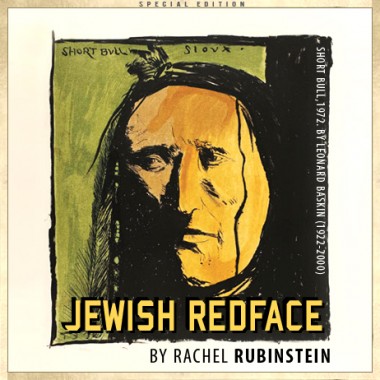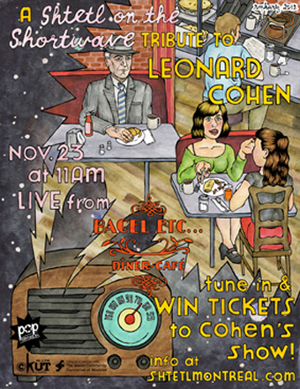
My husband recently bought me a lithograph as a gift. It is a portrait of Short Bull, a Sioux leader, soldier, and eventual performer in Buffalo Bill’s Wild West shows. My husband bought it for me not only because I am interested in representations and appropriations of Native people but because I am particularly interested in the ways in which Jews fantasized, wrote about, identified with, and circulated images and stereotypes of Indians. “Short Bull Sioux” was painted by Leonard Baskin, the yeshiva-educated son of a Brooklyn rabbi who became a famous artist and local luminary in Northampton, our own Western Massachusetts shtetl. The Jewish Virtual Library calls Baskin “one of the universal artists of the 20th century.” The work is part of Baskin’s Native American series of the 1970s, commissioned by the National Park Service for its illustrated handbook on Custer National Park (now called Little Big-Horn National Park). Baskin was open in his contempt for Custer and his sympathetic identification with Short Bull, which is of a piece with nearly all of the writers I examine. My husband calls “Short Bull Sioux” his contribution to my Jewish Redface collection.
The ways that Jewish immigrants to the United States willed themselves to feel at home in their adopted country are by now well-trodden territory, though the significance of indigenous people in this story is not. Constantly interrogating and examining their own indigenousness and their own sense of being “at home,” Jews have imagined in Native America a mirror for their anxieties and desires. This was yet another way to work out the collision between Jewish “tribalism” and modern, Enlightenment universalism, between commitment to the Diaspora and to variously imagined homelands, between a remembered history of dispossession and oppression and the new possibility for full civic belonging. Jewish preoccupation with the indigenous peoples of the Americas has a complicated history—one which draws directly upon the secular Jewish identities that had been invented in Europe. Jewish nationalism and communism, the twin legacies of European Jews, would become among the most powerful mediating ideas between immigrant Jews and their imagined Indians.
The story begins as early as the 17th century, when a Portuguese crypto-Jew named Antonio de Montezinos claimed to have encountered descendants of the ten lost tribes of Israel in the mountains of Brazil. They spoke to him in Hebrew and called him “brother.” Montezinos’ narrative, publicized all over Europe and its colonies, would become the most significant piece of evidence for the enormously popular theory that the Native peoples of the New World were in fact the lost Israelites. Later, in the early 19th century, Mordechai Manuel Noah attempted to establish a sovereign Jewish nation in upstate New York into which he would invite Indians, to be “reunited with their brethren.” Noah’s unsuccessful Jewish-Indian nation has served as literary inspiration for contemporary writers like Ben Katchor (The Jew of New York), Michael Chabon (The Yiddish Policeman’s Union), Nava Semel (I’srael; in English Isra-Island) and others, who have written about havens of Jewish refugees and their encounters with Indians.
Jewish immigrants, making their way westward in the 19th century, often encountered actual Native communities through trade and in violent conflicts over land and resources. But the vaudeville circuit was also a site of encounters between Jews and Indians. There’s an old joke that the roles of “Indians” on the vaudeville stage (and later, in Hollywood films) were usually performed by Jewish performers in redface. Beginning with the 1895 Yiddish playlet “Tsvishn Indianer” (“Among Indians”), and continuing through burlesque songs such as “Yonkl the Cowboy Jew,” “I’m a Yiddish Cowboy” (about an intermarriage between a Jewish cowboy and an Indian maiden), and “Moshe from Nova Scotia” (about a “Jewish Eskimo”), there is a long, fascinating, and often troubling tradition of urbane immigrant Jews either offensively or comically performing an encounter with the mythical American West and its mythologized inhabitants. The tradition continued with “Big Chief Dynamite,” about a “tough Jew Indian boy,” and continued further with Fanny Brice’s Ziegfield Follies song “I’m an Indian” (see video above). It culminates with Mel Brooks’ late-20th-century turn as a Yiddish-speaking Indian chief in Blazing Saddles, Gene Wilder’s Polish immigrant rabbi crossing the continent in The Frisco Kid, and Rob Morrow’s New York Jewish doctor trapped in a tiny Alaskan village in the 1990s television series Northern Exposure.
But Jewish engagement with Native Americans was also fueled by more serious literary and political motivations. For instance, in the first half of the 20th century, three Hebrew poets published epics on Native American themes. Longfellow’s “The Song of Hiawatha” was translated into Yiddish and Hebrew in the early 20th century. Translations and imitations of Native American chants into Yiddish appeared in Shriftn, published by a group of secular modernist Yiddish poets in New York. Der Hammer, the Yiddish communist monthly, devoted its July 1928 issue to Native America, featuring translations of poetry, renditions of traditional tales, and original fiction. The Yiddish press both in Eastern Europe and the U.S. regularly featured articles on Native cultures. Some Yiddish writers like Yitskhok Raboi and Sh. Dayksel developed a reputation for writing about Jews, the West, and Native people. In nearly all cases, these articles were saturated with the radical left-wing politics characteristic of secular Yiddish literature. In English, secular radical Jewish writers such as Tillie Olsen, Michael Gold, Nathanael West, and Howard Fast critiqued fascism, colonialism, and racism by referencing Native American history. And beginning in the late 1960s and 70s, Bernard Malamud and Henry Roth produced complex meditations on Jewish and Native national identities, genocide, suffering, and power, just as Baskin was working on his Native American series. And there are, of course, many more.
These days, I am struck by how many young North American radical Jews continue to celebrate their diasporic histories but also long for indigenousness, a feeling of rootedness and territorial belonging. Not in Israel, though. Palestinian indigenous claims (and frequent gestures of identification with Native peoples of the Americas) make this risky. Not even in North America, though I often think of the Jewish farming movement as an expression of indigenous longing. Instead, young Jews are looking to the territories of their ancestors: Eastern Europe, or North Africa and the Middle East. This growing romance with Ashkenazi or Sephardic/Mizrahi indigenousness is perhaps the newest variation of Jewish Redface, which for me is all about the desire to be simultaneously cosmopolitan and indigenous, diasporic and rooted, universalist and tribal.
___________________________________________________
 Rachel Rubinstein is associate professor of American literature and Jewish studies at Hamshire College. She is the author of Members of the Tribe: Native America in the Jewish Imagination (Wayne State University Press, 2010). This article is part of Indigenous Shtetl,
Rachel Rubinstein is associate professor of American literature and Jewish studies at Hamshire College. She is the author of Members of the Tribe: Native America in the Jewish Imagination (Wayne State University Press, 2010). This article is part of Indigenous Shtetl,
a special edition of Shtetl Magazine.





